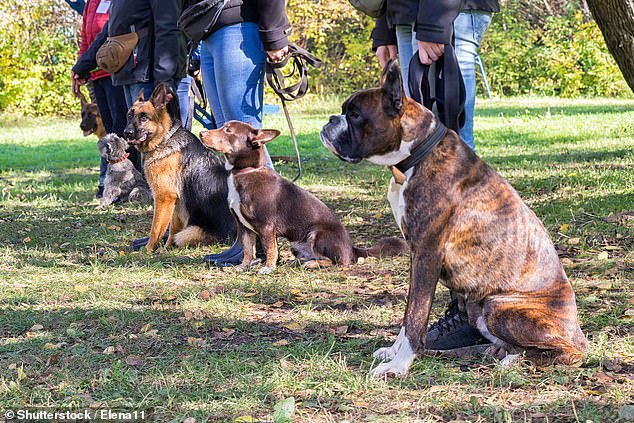Scientists discover a new type of training that makes dogs behave better… here’s how YOU can do it at home
Dog training can be a tricky process that doesn’t always yield positive results, but a new study has found that there is another way to train your furry friend.
Researchers from Aberystwyth University in Britain found that by using ‘scent training’ they could break dogs’ bad behavior and improve and control their impulses.
Previous studies have included only highly trained working dogs compared to untrained dogs, but this is the first time researchers have tested scent training on two test groups of untrained dogs.
The training required dogs to focus on one odor to the exclusion of everything else, and found that those given odor training were able to complete tasks more efficiently and had better cognitive function.
Bad behavior in dogs can be curbed through scent training, according to a new study

Dogs lined up and had to find where the treat was placed under a pot. If they chose the wrong jar, they were shown the treat, but did not receive the reward
Our furry friends can misbehave for a variety of reasons, including receiving inconsistent training, their owners using negative learning experiences, or rewarding bad behavior.
But by following the steps outlined in the study, pet owners can finally get their rambunctious pooch under control once and for all.
Through their research, the researchers found that experience can overcome these differences and showed that “training and experience may be as important as genetics in determining canine cognitive performance.”
The team recruited 40 dogs of varying levels of training and owners were asked to complete a questionnaire with information about their pet’s gender, neuter status, breed and age group.
Researchers then divided the dogs into two groups to determine whether their ability to detect odors would improve their cognitive ability.
The first group was given the ‘detour task’, where they had to navigate around a transparent barrier to get a treat.
In the second group, the researchers said “Look” to the dog to get its attention and showed it a treat before putting it under a pot.
The odor training was divided into three different phases with a maximum of twenty trials each: introduction, training and the test phase.

Owners can use scent training, agility training and puzzles to train their dogs

Dogs’ ability to take on a particular role was historically based on their breed, training level and human dependence
In the first phase, only one pot was used, but the researchers changed the location. In the training phase the pot moved up to two pots and moved up to three pots for the test phase.
All the pots were smeared with a pâté scent, so that the dogs could not distinguish by sniffing where the treat was.
If the dog did not respond to find the treat within 20 seconds of release or if it came into contact with the wrong pot, the dog was shown the treat but received no reward.
Their findings showed that the second group trained to sniff the treats behaved better than those who had to avoid an obvious obstacle.
Dogs perform a variety of roles, from seeing-eye dogs to herding livestock, assisting in rescue efforts and simply being a companion to their human – but their ability to take on each role largely depends on their breed, training level and motivation. , problem-solving skills and human dependency, among others.
“We are a nation of dog and animal lovers, and for good reason,” said Sarah Dalesman, who co-supervised the study.
‘They are very important to our lives and play a variety of roles, from providing essential companionship to working in the emergency services.
‘For these and many other reasons, it is important to understand their behavior and what influences it.’
This training method can easily be applied at home, said co-author Sarah Dalesman Newsweekand adds: ‘Scent work is a fantastic activity for dogs to do with their owners.
‘It’s suitable for all ages, from young puppies to older dogs, and a really easy activity to practice at home as you don’t need a lot of equipment.’
She continued, “Even hiding some of the dog’s normal food so that he has to sniff it can provide him with important mental stimulation.”
There are other steps owners can take if scent training is not compatible with the way their dog learns, including puzzle solving and agility training.
Puzzle training can be implemented using toys that hold food or treats and force the dog to work for his reward.
The types of toys include hollow bone or rubber toys that can be filled with peanut butter and hard plastic toys with mazes or compartments for treats.
The idea is to provide a mental and physical stimulus that can come in handy when a dog needs to be left alone or confined.
Another option is agility training – which sends a dog through a preset obstacle course with tunnels, jumping tables and poles – giving him the opportunity to learn problem-solving skills.
“It’s worth exploring different training activities with your dog and finding out what you and your dog really enjoy doing together,” Dalesman told Newsweek.
‘My own dog loves scent work, but he’s really into dog agility, so we’re doing more agility training at the moment.
“It’s great to do the scent training too, though, because he can still do this when he gets too old for dog agility, which is a physically demanding sport,” she said.
The researchers said more studies need to be conducted to test the theory that scent training can be beneficial for training our four-legged friends, and they want to test this in future studies.
